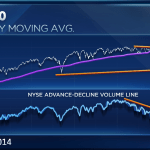Read MoreDon’t fret if Santa hasn’t showed up on Wall St. yet
Tuesday’s data includes S&P/Case-Shiller home prices at 9 a.m. and consumer confidence at 10 a.m. there is also a 5-year Treasury auction at 1 p.m. ET.
Luschini said he’s still holding out hope for a year-end rally that will take the S&P 500 to positive territory for the year. The market benchmark was down 0.1 percent for the year so far after closing down 4 points at 2,056 Monday. The Dow was off 23 points to 17,528, and it’s off 1.6 percent year-to-date.
The 10-year Treasury yield, at 2.23 percent, is just about where it was at this time last year. “My point is subdued economic activity results in muted investment returns,” said Luschini. For 2016, he expects “kind of more of the same, if you will, a sequel to 2015.”
Read MoreStreet: Volatile year ahead, buy these stocks
He pointed out that both the 10-year yield and S&P 500 are little changed, despite the volatility. “On a price basis, and yield basis, we made no progress…. I think we end up nudging a gain (for 2015). Equities will end up a little bit better than bonds and cash, and the margin of error is thin,” he said.
For 2016, his year-end target for the S&P 500 is 2,155.
Read MoreFive hot sectors for 2016
Luschini said oil prices could determine the fate of the S&P 500 for 2015. West Texas Intermediate futures fell 3.4 percent Monday to $36.81 per barrel, and Brent was down $1.28 at $36.61 per barrel at 2:30 p.m. ET.
On Monday, from Saudi Arabia to Japan, a series of headlines combined to slam oil futures and also reaffirmed that what’s ailing oil is not going away anytime soon.
First, worries about China’s growth were rekindled after a report that showed Chinese industrial profits down 1.4 percent in November. Shanghai stocks were down more than 2.5 percent, and the report also weighed on energy, as did a report that oil sales in Japan fell to a 46-year low.
Then Russia chimed in with comments from Deputy Prime Minister Arkady Dvorkovich, who said he expects the decline in investment in oil production to result in higher crude prices. But he was also quoted by Tass as saying Brent could reach $20 to $25 per barrel briefly before rebounding
Saudi Arabia contributed to the gloom when it reported a budget deficit of $97.9 billion in 2015 and said it would cut spending and look to derive revenues from sources other than oil.
“The news about Saudi Arabia cutting its budget rather than its production means they’ll continue to put supply on the market, and that’s weighing on oil,” said Luschini.
Read MoreWill oil continue to drive volatility in 2016?
Iran was also in the news, with its oil minister saying Iran could immediately return 500,000 barrels a day to the market when sanctions against it are lifted.
At the same time, the U.S. oil industry is ramping up to export crude into the already oversupplied world market, though analysts expect those exports to go slowly until the price of crude recovers.
Enterprise Product Partners was the first company to announce a shipment, when it said last week it is providing pipeline and marine terminal services for Vitol’s 600,000-barrel cargo of domestic light crude for the first week in January. Pioneer Natural Resources said it would begin exporting by mid-2016.
The end of the U.S. export ban has served to drive WTI slightly higher in recent sessions. But it has also weighed on Brent, pushing it below WTI and breaking a long-running trend of higher Brent, lower WTI prices. Congress voted to end the ban as part of the budget package passed this month.
“It is quite striking that within a few days of the lifting of the ban, the psychological impact was such that the WTI discount disappeared. It didn’t waste any time,” said Daniel Yergin, vice chairman of IHS. “It was an artificial distortion of the market, and now it’s gone. Once again, it’s a global market.”
[“source -cncb”]




